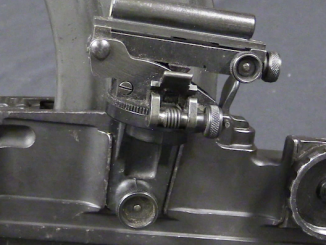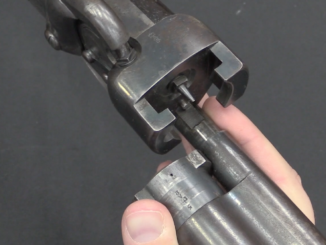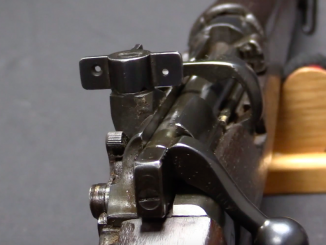BSA (Birmingham Small Arms) was the largest private arms maker in the UK during World War One, and when the war ended it of course saw its huge military contracts evaporate. One of BSA’s efforts to develop new markets and product lines was to devise a series of self-loading pistols. These also involved the use of a line of new belted rimless cartridges made by Kynoch. Very few of there pistols survive today, and this .45 ACP example is one of them. It is a short recoil, rotating barrel design, with a trigger mechanism very similar to the FN 1910, and the rotating barrel system very similar to the Steyr-Hahn 1912.
The best (and pretty much only) source of information on these pistols is an article written for the HBSA by this pistol’s former owner, Dr. Geoffrey Sturgess. The Julia auction house has thoughtfully provided a copy of the article in PDF format for folks who would like to learn more.




Shame it never took off, except for the mag release looks like are really nice and surprisingly modern looking design, but I might be a bit biased cause it’s partially a more elegant Steyr 1912 and I’m a big fan of that design. The designer’s may have ‘borrowed’ from their inspirations but it looks like some thought went into what to borrow.
Boy, that REALLY looks like a Remington Model 51.
I had the same thought and for a long time had been wondering whether BSA had taken a license on Pederson’s patents.
There just was not any information available, and close examination of the very few available photos did show a lot of differences to the Pedersen designs.
Now we know that it is even more interesting.
According to Mr. Sturgess’s text, simple blowback versions in different calibers are also present and excepting minor details, they all follow the general outline of FN 1910 design. But, it seems, rotating barrel lock construction is unusual and amazing. Steyr 1912 take down needs barrel removal from receiver after slide dismount, Nickle design needs barrel dismount with camming block and most recent Yaroslav Kuracina pistol follows nearly Walther PP fashion. BSA’s way is as simple as blowback relatives, with a possible difference that, barrel needs to be dismounted from breech side of slide after take down. Turning a blowback pistol to locked breech with such simple construction changes is really deserves calling “Extra Ordinary”. Designing the pistol had occured at ages when FN patent rights being still alive as limiting the outland
sales. therefore halting the possible production. However, the pistol contains some attractive features not found in FN design like; Slide stop, cocking indicator grip safety also permitting to manually retract the slide without firmly grasping the pistol when initialy uncocked, roller equipped trigger bar/slide contact and tight toleranced disconnector cut under the breech. Striker and trigger bar connection is offset to make room for centiraly located slide stop relation. Nearly unknown but glorious design for rotating barrel lock that is very possible to be dublicated in a future plastic frame handgun.
Forgot to thanks Ian for taking such a glorious design into daylight. What about to do the same for Walther Toggle Lock Pistol seeming present in James D Julia’s archieves.
I SECOND My namesake, Chris Morton’s, observation that it looks like a Remmy Mod 51 (on steroids)!!!
Just for future reference we pronounce it Bur-ming’um.
A shame that BSA only do airguns now, what was once the heart of Britain’s firearms industry is now only a few shotgun makers along one side of a car park. Legislation and a dwindling market killed it off.
Great video and thanks for the pdf too. Amazing to contrast these elegant pistols with the Whiting design.
That recessed or scalloped section of slide looked oddly familiar to me, and I found something like it in Ezell’s Handguns of the World on p.255. One Spanish-made Browning 1910 copy, the Rex, had a similar “thinned” section on top of its slide at the rear with a loaded-chamber indicator in the center “rib”. Exactly why you’d want to do that on a blowback I don’t know, unless the action wasn’t cycling reliably with the extra mass present (?).
cheers
eon
The oval witness holes in the magazine may have been due to the pitch between the hole being incorrect. Opening them up into ovals could have been a quick way of fixing the prototype. Loading the magazine could give a clue to this by telling us if the cartridges were centred.
One of Ian V Hogg’s books describes the BSA gun as .40 calibre.
Hogg is an absolute Tw@ for not referencing his sources of info, so there is no way to determine whether this was a typo or was based on actual info.
If there had been a .40 gun, it is conceivable that someone put the viewing holes of the prototype .45 mag at the .40 spacing.
I think the firing pin would be operating as the ejector, not the extractor.
Yeah, I misspoke.
You can’t get away with anything round here!
Thanks for highlighting this unique and special firearm. Been interesting in information about he BSA cartridges and pistols for years now with no luck until your excellent exposition.
It’s got a very queer mag release, maybe it’s because it was a prototype i.e. About the other bits, or what? Bomber crews perhaps, accidents somehow… Or losing the mag, gun turrets scrambling around.
Seems a pain.
Maybe they had a problem with folks “diving” after flak, magazine’less panic… Well, get out etc. Maybe the mag buttons got depressed while scrambling out the turret, on say a 1911.
Nothing like BSA or owt these days, ROF, BAE I suppose… But it’s ballcocks, they’d make guns for ze Germans just pish.
Sad state of affairs, Hk reliant.
ROF gone, I meant.
Flying gloves, that would explain the indented cocking assist recesses on the slide.
That was a treat! I’d love to see that gun copied. I can dream, right?
Ian,
many thanks for sharing that wonderful pistol with us.
I’d often wondered how it worked, and had speculated in the past that perhaps it used Pedersen’s patents (Remington 51).
The only picture I had previously seen of it was in one of Ian V Hogg’s books.
Even in that poor photograph, it stood out as having what looked like very well designed ergonomics, with a raked grip for use in straighter armed firing stance, an unusually low bore axis, even by today’s standards and good protection for the web of the hand from the recoiling slide.
That stupid, pointless, murderous war…
If the pistol had come ten years earlier, it might have been a success.
I hope whoever the lucky new owner is, that they let you do a thorough job of disassembilng and recording the gun, and its shooting characteristics.
I wonder how well the design would stand up today as the basis for developing a sleek and easy pointing carry gun?
As to recreating the essence of the design, I wholeheartedly agree!
I have stated this regarding several unique if outdated firearms, and someone is always quick to cry “impossible!”
..It seems to me, that a gun that was created in the day of ruler, compass, pencil, lathe and hand-mill, should certainly be re-createable in the day of laser dimensional scanning, computerized simulation of operation, and advanced manufacturing techniques!
Perhaps we should recall that a few short decades ago, anyone who envisioned a video camera, computer, and phone in the pocket of every teenager would be laughably categorized as a shiftless, daydreaming, sci-fi geek wasting their time imagining the impossible…
I was lucky enough to purchase the .34 at the auction –